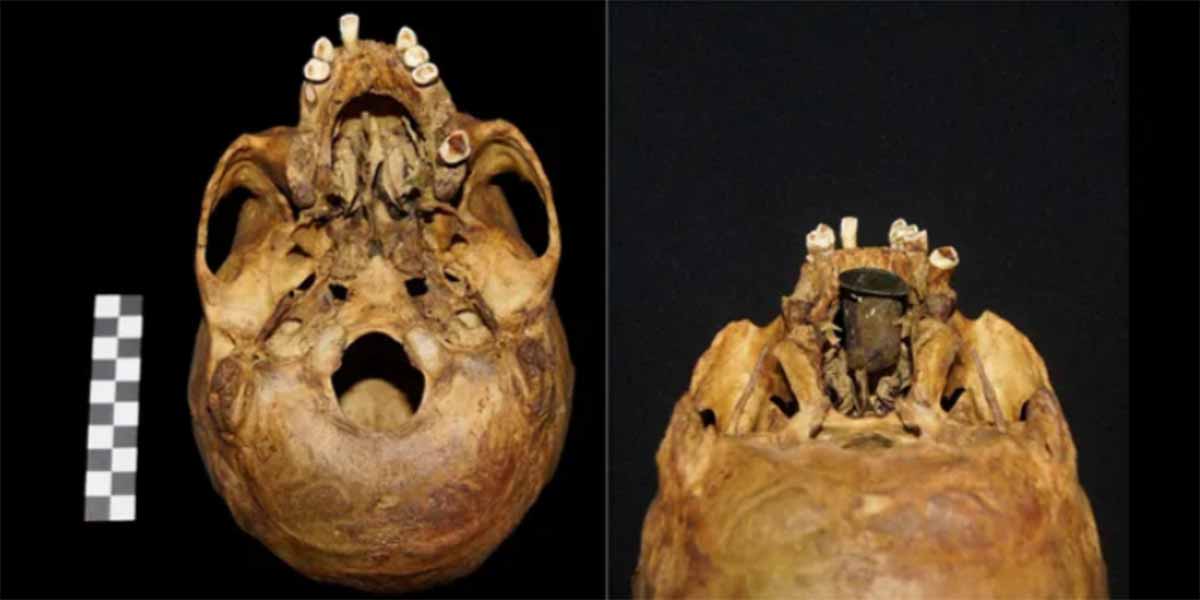Archaeologists in Poland working on the excavation of the Church of St. Francis of Assisi in Krakow have found something new, described as the first discovery of its kind in the country. The body of a man has been revealed to have a medical prosthesis in his mouth, an artificial insert which allowed him to live with a cleft palate.
Anna Spinek, an anthropologist at the Hirszfeld Institute of Immunology and Experimental Therapy in Poland, explained the discovery to Live Science. "This is probably the first such discovery not only in Poland but also in Europe. No such devices exist in institutional and private collections (Polish and foreign)."


The device, described as a palatal obturator, was designed to fit into the roof of the man’s mouth. It would fit into the nasal cavity of the man replacing his hard palate.
A cleft palate occurs during gestation when the roof of the mouth, specifically the hard palate, doesn’t completely close. As a result the nasal cavity is directly linked to the mouth and foreign substances can enter this cavity. A cleft palate typically causes problems associated with breathing, talking and eating.
The authors note in their paper that the first attempts to replace missing parts of the palate are likely to date back to antiquity. The Greek orator Demosthenes (384 - 322 BC) suffered from a congenital cleft palate and may have used pebbles to fill open gaps inside his mouth.
Cleft palates are resolved today with relatively straightforward surgical procedures, but this was not available to the man 300 years ago. Instead he found another solution: this device, which was inserted into his mouth as a prosthetic.

The device itself, which has been described as “exceptional”, consists of two parts. A metal plate mimicking the hard palate is attached to a pad made of wool, designed to secure the device comfortably when fitted into the mouth.
During the removal of the woolen pad small particles of a yellow and a green material were noted, which the researchers believe are traces of gold and copper. It appears that the plate was covered in a thin layer of copper, and then gold, to provide a barrier and prevent infection by preventing secretions from the nasal cavity being absorbed.
The pad also appears to have had a copper and gold layer to prevent infection. The prosthetic is overall concave in shape, and designed to arch up into the nasal cavity leaving a hollow in the mouth, just as a natural hard palate would.
To further understand the composition of the prosthesis, the researchers analyzed it under a scanning electron microscope and with X-ray spectroscopy, which analyzes chemical composition of a sample. They found that the metal pieces were indeed largely made of copper, with considerable amounts of gold and silver.
The wool was also analyzed and found to contain traces of silver iodide. It is likely this was added to the pad for its antimicrobial properties.
The obturator had been originally observed when the crypt containing the man was excavated from 2017 to 2018, where it remained largely where it should be between the skeletal jaws of the body. However despite further analysis it is not yet possible to tell how well the prosthesis actually functioned.
Today, it is difficult to assess how well the obturator fitted or how tight a seal it provided," the authors wrote in their paper. "However, modern-day patients struggling with similar health problems describe the use of a prosthesis providing improvements in speech (which becomes clearer) and increased comfort when eating."
Top Image: The skull of the man found in Poland from behind. On the left the absence of a hard palate can be clearly seen. The photograph on the right shows how the gold prosthesis was fitted. Source: Anna Spinek; © 2024 Elsevier Ltd / Live Science.

 www.ancient-origins.net
www.ancient-origins.net
Anna Spinek, an anthropologist at the Hirszfeld Institute of Immunology and Experimental Therapy in Poland, explained the discovery to Live Science. "This is probably the first such discovery not only in Poland but also in Europe. No such devices exist in institutional and private collections (Polish and foreign)."
The device, described as a palatal obturator, was designed to fit into the roof of the man’s mouth. It would fit into the nasal cavity of the man replacing his hard palate.
A cleft palate occurs during gestation when the roof of the mouth, specifically the hard palate, doesn’t completely close. As a result the nasal cavity is directly linked to the mouth and foreign substances can enter this cavity. A cleft palate typically causes problems associated with breathing, talking and eating.
The authors note in their paper that the first attempts to replace missing parts of the palate are likely to date back to antiquity. The Greek orator Demosthenes (384 - 322 BC) suffered from a congenital cleft palate and may have used pebbles to fill open gaps inside his mouth.
Cleft palates are resolved today with relatively straightforward surgical procedures, but this was not available to the man 300 years ago. Instead he found another solution: this device, which was inserted into his mouth as a prosthetic.
The device itself, which has been described as “exceptional”, consists of two parts. A metal plate mimicking the hard palate is attached to a pad made of wool, designed to secure the device comfortably when fitted into the mouth.
During the removal of the woolen pad small particles of a yellow and a green material were noted, which the researchers believe are traces of gold and copper. It appears that the plate was covered in a thin layer of copper, and then gold, to provide a barrier and prevent infection by preventing secretions from the nasal cavity being absorbed.
The pad also appears to have had a copper and gold layer to prevent infection. The prosthetic is overall concave in shape, and designed to arch up into the nasal cavity leaving a hollow in the mouth, just as a natural hard palate would.
To further understand the composition of the prosthesis, the researchers analyzed it under a scanning electron microscope and with X-ray spectroscopy, which analyzes chemical composition of a sample. They found that the metal pieces were indeed largely made of copper, with considerable amounts of gold and silver.
The wool was also analyzed and found to contain traces of silver iodide. It is likely this was added to the pad for its antimicrobial properties.
The obturator had been originally observed when the crypt containing the man was excavated from 2017 to 2018, where it remained largely where it should be between the skeletal jaws of the body. However despite further analysis it is not yet possible to tell how well the prosthesis actually functioned.
Today, it is difficult to assess how well the obturator fitted or how tight a seal it provided," the authors wrote in their paper. "However, modern-day patients struggling with similar health problems describe the use of a prosthesis providing improvements in speech (which becomes clearer) and increased comfort when eating."
Top Image: The skull of the man found in Poland from behind. On the left the absence of a hard palate can be clearly seen. The photograph on the right shows how the gold prosthesis was fitted. Source: Anna Spinek; © 2024 Elsevier Ltd / Live Science.

300 Year Old “Exceptional” Prosthesis made of Gold and Copper Discovered in Poland
Archaeologists in Poland working on the excavation of the Church of St. Francis of Assisi in Krakow have found something new, described as the first discovery of its kind in the country.

